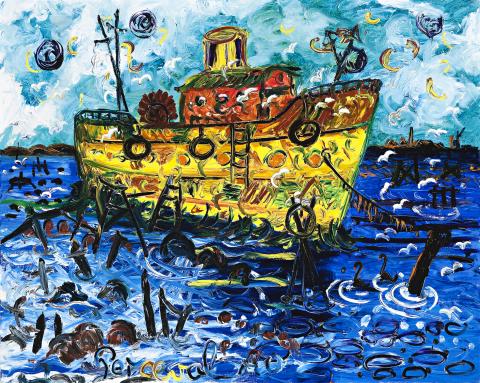TUG BOAT, WILLIAMSTOWN PORT, c.1993
JOHN PERCEVAL
oil on linen
80.0 x 100.0 cm
signed lower left: Perceval
Queensland Art Brokering
Private collection, Sydney
Company collection, Melbourne
In many respects, John Perceval, the youngest member of the famed Angry Penguins group of artists, had the most distinctive personal style. Marked by excitable whirls, luscious paint and spontaneous gesture, his paintings fuse the vivacity of expressionism with a pure delight in the world around him. In spite of many personal tribulations – childhood polio, family disruption, alcoholism and psychiatric problems – Perceval’s artworks stand as a testament to his unique vision.
Bayside subjects, in particular the port of Williamstown, were a recurring motif in his work. Perceval first encountered Williamstown in the company of fellow artist Charles Blackman in the early 1950s, an experience he described as ‘like discovering Venice.’1 In its cluttered waterways, the artists discovered rusting hulks, tugs, pontoons and other working vessels swept over by birdlife and the elements. It was an industrial paradise underpinned by the vagaries of nature. Perceval’s initial series of Williamstown paintings formed the core of his first solo exhibition, an event which also launched Australian Galleries. Rightly considered now as masterworks in Australian art history, Perceval then displayed a second series as part of the controversial Antipodeans exhibition of 1959 before leaving for London for an extended period.
Sadly, after many years of battling his demons, Perceval had himself voluntarily admitted to the Larundel psychiatric hospital in 1977 beginning almost a decade of self-imposed confinement. However, he did not stop drawing and on his release in 1986, began reconnecting with painting as well. Now with a part-time carer, Perceval started revisiting his old haunts with Williamstown being a prime and favoured destination. Whereas the original series from the 1950s had a relatively matt surface and incorporated scumbled, muted backgrounds, the new works were rich, bold and bombastic. Colour was liberated into vivid patches incorporating navy, azure, red and gold, with the latter evoking his favourite bloom, the sunflower. Tug Boat, Williamstown Port is a joyous painting and Perceval has keenly observed the effect of the wind as it flicks across the water, scudding clouds in its wake. Although physically frail, the sheer energy inherent within the painting belies the artist’s condition. It is important to note that when the original paintings were exhibited in 1956, ‘(c)ritical reaction … rested in the uncaring joy which was thought to have inspired their creation. Phrases like ‘wild untrammelled joy’ and ‘joie de vivre’, once stated, became consistent, stock-in-trade lines for newspaper articles, and reviews and were used to typify his entire body of work.’2 The same mistake could also be made when describing Tug Boat, Williamstown Port, except that the painting is also technically sound, held together by a surprising surety of touch in which none of the pure colour has degraded into murky browns, a pitfall facing any artist working with thick wet paint who does not truly understand how to use a brush.
1. Reid, B., Of Light and Dark: the art of John Perceval, National Gallery of Victoria, Melbourne, 1992, p. 26
2. Allen, T., John Perceval, Melbourne University Press, Melbourne, 1992, p. 98
ANDREW GAYNOR
